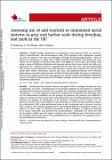Files in this item
Assessing use of and reaction to unmanned aerial systems in gray and harbor seals during breeding and molt in the UK
Item metadata
| dc.contributor.author | Pomeroy, Patrick | |
| dc.contributor.author | O’Connor, L. | |
| dc.contributor.author | Davies, P. | |
| dc.date.accessioned | 2015-09-16T12:10:04Z | |
| dc.date.available | 2015-09-16T12:10:04Z | |
| dc.date.issued | 2015-09-15 | |
| dc.identifier | 212454885 | |
| dc.identifier | a3977a84-0a3d-440e-8090-7ecd1f9b007e | |
| dc.identifier | 000446100500004 | |
| dc.identifier | 85101129367 | |
| dc.identifier.citation | Pomeroy , P , O’Connor , L & Davies , P 2015 , ' Assessing use of and reaction to unmanned aerial systems in gray and harbor seals during breeding and molt in the UK ' , Journal of Unmanned Vehicle Systems , vol. 3 , no. 3 , pp. 102-113 . https://doi.org/10.1139/juvs-2015-0013 | en |
| dc.identifier.issn | 2291-3467 | |
| dc.identifier.other | ORCID: /0000-0003-1603-5630/work/46569074 | |
| dc.identifier.uri | https://hdl.handle.net/10023/7486 | |
| dc.description | This work was supported by UK NERC National Environmental Research Council National Capability funding to SMRU, NERC grant No. GE08-001358 to PP, through UK DEFRA support to SMRU, and by development grants from MASTS and Chester Zoo. | en |
| dc.description.abstract | Wildlife biology applications of unmanned aerial systems (UAS) are extensive. Survey, identification, and measurement using UAS equipped with appropriate sensors can now be added to the suite of techniques available for monitoring animals – here we detail our experiences in using UAS to obtain detailed information from groups of seals, which can be difficult to observe from land. Trial flights to survey grey and harbour seals using a range of different platforms and imaging systems have been carried out with varying success at a number of sites in Scotland over the last two years. The best performing UAS system was determined by site, field situation, and the data required. Our systems routinely allow relative abundance, species, age--class, and individual identity to be obtained from images currently, with measures of body size also obtainable but open to refinement. However, the impacts of UAS on target species can also be variable and should be monitored closely. We found variable responses to UAS flights, likely related to the animals’ experience of previous disturbance. | |
| dc.format.extent | 5179757 | |
| dc.language.iso | eng | |
| dc.relation.ispartof | Journal of Unmanned Vehicle Systems | en |
| dc.subject | UAS | en |
| dc.subject | Wildlife | en |
| dc.subject | Seals | en |
| dc.subject | Photo ID | en |
| dc.subject | Photogrammetry | en |
| dc.subject | Behaviour | en |
| dc.subject | QH301 Biology | en |
| dc.subject | QL Zoology | en |
| dc.subject | NERC | en |
| dc.subject.lcc | QH301 | en |
| dc.subject.lcc | QL | en |
| dc.title | Assessing use of and reaction to unmanned aerial systems in gray and harbor seals during breeding and molt in the UK | en |
| dc.type | Journal article | en |
| dc.contributor.sponsor | NERC | en |
| dc.contributor.sponsor | NERC | en |
| dc.contributor.institution | University of St Andrews. School of Biology | en |
| dc.contributor.institution | University of St Andrews. Sea Mammal Research Unit | en |
| dc.contributor.institution | University of St Andrews. Marine Alliance for Science & Technology Scotland | en |
| dc.contributor.institution | University of St Andrews. Scottish Oceans Institute | en |
| dc.contributor.institution | University of St Andrews. Centre for Research into Ecological & Environmental Modelling | en |
| dc.identifier.doi | 10.1139/juvs-2015-0013 | |
| dc.description.status | Peer reviewed | en |
| dc.identifier.grantnumber | NE/G008930/1 | en |
| dc.identifier.grantnumber | Agreement R8-H12-86 | en |
This item appears in the following Collection(s)
Items in the St Andrews Research Repository are protected by copyright, with all rights reserved, unless otherwise indicated.

